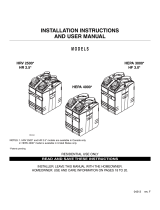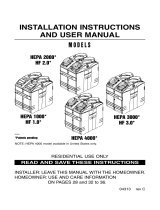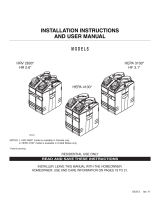Lifebreath TFP3000HEPA RTO Installation guide
- Type
- Installation guide
This manual is also suitable for
Lifebreath TFP3000HEPA RTO is an air cleaner that uses Turbulent Flow Precipitation (TFP) and a High-Efficiency Particulate Air (HEPA) filter to remove up to 99% of particulate matter from the air in your home. It is designed to be installed in a conditioned space with easy access for maintenance and an annual checkup and is usually installed in a basement area where airflow noise will be negligible to the occupants. The TFP air cleaner should be installed in a location that allows for proper airflow and easy access for maintenance.
Lifebreath TFP3000HEPA RTO is an air cleaner that uses Turbulent Flow Precipitation (TFP) and a High-Efficiency Particulate Air (HEPA) filter to remove up to 99% of particulate matter from the air in your home. It is designed to be installed in a conditioned space with easy access for maintenance and an annual checkup and is usually installed in a basement area where airflow noise will be negligible to the occupants. The TFP air cleaner should be installed in a location that allows for proper airflow and easy access for maintenance.
















-
 1
1
-
 2
2
-
 3
3
-
 4
4
-
 5
5
-
 6
6
-
 7
7
-
 8
8
-
 9
9
-
 10
10
-
 11
11
-
 12
12
-
 13
13
-
 14
14
-
 15
15
-
 16
16
Lifebreath TFP3000HEPA RTO Installation guide
- Type
- Installation guide
- This manual is also suitable for
Lifebreath TFP3000HEPA RTO is an air cleaner that uses Turbulent Flow Precipitation (TFP) and a High-Efficiency Particulate Air (HEPA) filter to remove up to 99% of particulate matter from the air in your home. It is designed to be installed in a conditioned space with easy access for maintenance and an annual checkup and is usually installed in a basement area where airflow noise will be negligible to the occupants. The TFP air cleaner should be installed in a location that allows for proper airflow and easy access for maintenance.
Ask a question and I''ll find the answer in the document
Finding information in a document is now easier with AI
Related papers
-
Lifebreath TFP3000HEPA User manual
-
Lifebreath METRO 120ERVD-ECM Installation guide
-
Lifebreath METRO 120ERVD-ECM Owner's manual
-
Lifebreath 350DCS Installation guide
-
Lifebreath RNC4-TPD Owner's manual
-
Lifebreath TFP2000 User manual
-
Lifebreath 170 ERVD Owner's manual
-
Lifebreath 1200Pool Owner's manual
-
Lifebreath 170 ERVD Installation guide
-
Lifebreath RNC4-TPD Installation guide
Other documents
-
Platinum TFP-PLATINUM Operation and Installation Manual
-
Lennox 887M User manual
-
 Venmar HRV2500 User guide
Venmar HRV2500 User guide
-
Broan HEPA 4000 User manual
-
Broan HEPA2000 User manual
-
 Venmar HEPA2000 User guide
Venmar HEPA2000 User guide
-
Beam HEPA Air Filter Central Owner's manual
-
Hunter Fan 30350 User manual
-
Hunter Fan 30350 User manual
-
 Venmar HEPA3100 User manual
Venmar HEPA3100 User manual


















